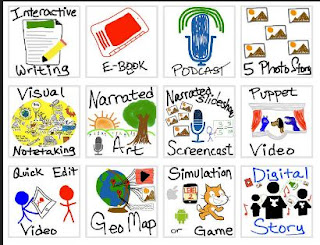Is the Assessment Meaningful? A reflection on Objective Assessments
When cooking traditional is usually the most valuable way to
make sure the dish or baked goodies turn out perfect. However, like with the world around us change
can be very helpful and usually doesn’t take away the main details. Education is following the same process like
many things we experience in our world today.
Traditionally instructors would teach students various concepts related
to a unit of learning and provide students with a large assessment at the end. The assessments are usually high in point
value and consist of various questions delivered on a Scantron sheet.
 |
| Example of "I can" statements https://www.theartofed.com/2013/02/21/how-i-can-statements-can-work-for-you/ |
As we are continuously evolving to teaching our 21st century students we must incorporate change how we assess these unique individuals. Even our learning objectives are changing into “I can statements” which are written in student friendly language. This new form of language should help students learn to take ownership of their learning and reflect on their work based on the unit curriculum standards. Student will be able to gauge if their work meets those requirements of the lesson or even build a discussion with the instructor (Crockett, 2015).
Many of us have relied on objective assessments such as tests because they have been reliable and somewhat fair in the past. However, as we now try to understand the individual student and their personable abilities. Traditional objective assessments may provide a false observation of the student. It measures learning from a quantitative perspective. A quantitative method uses numbers to interpret data. It delivers generalize results and takes a broader view of the audience (Reis, n.d.). On the other hand, qualitative assessments focus on understanding how people make meaning of an experience. The instructor is provided with a rich view of the intended outcome, hence an authentic assessment. Authentic assessments are supportive of the real-world. Authentic assessments allow students to perform real-world tasks that are meaningful to learning (Mueller, 2016).
 |
| https://ponseds113journal.wordpress.com/2013/11/16/traditionally-authentic-2/ |
Technology is supportive of authentic assessments. Instructors can create rubrics to measure student’s
mastery of concepts which give criteria’s to score students understanding. Instructors can also have students create
visual presentations as a form of assessment such as project-based activities
and assessments online such as Kahoot! or Socrative. There can even be student created portfolios
to showcase their mastering of various skill-sets. The instructor can conduct individual interviews
with students as a form of an assessment.
There are many other options besides creating and delivering the
standard test. We are now accountable
for understanding the growth of the whole student. This is imperative as we select our form of
assessments to meet the 21st century student.
References:
Crockett, H. (2015, November 18). How I CAN Statements Can
Work For You. Retrieved June 19, 2017, from https://www.theartofed.com/2013/02/21/how-i-can-statements-can-work-for-you/
Mueller, J. (2016). What is Authentic Assessment? Retrieved May 7, 2018, from http://jfmueller.faculty.noctrl.edu/toolbox/whatisit.htm
Reis, R. (n.d.). Quantitative and Qualitative and Assessment
Methods. Retrieved May 7, 2018, from
https://tomprof.stanford.edu/posting/1199

Comments
Post a Comment